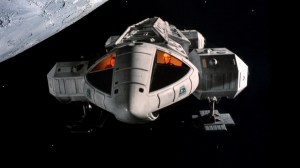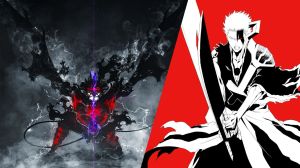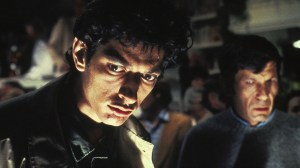[SPOILER WARNING: This interview includes SPOILERS for Star Trek: Strange New Worlds’ first season finale, “A Quality of Mercy.”] Today, Star Trek: Strange New Worlds closes out its first critically-acclaimed season with the episode “A Quality of Mercy.” The episode is Strange New Worlds‘ first foray into time travel, with the Christopher Pike (Anson Mount) of the future visiting the present-day Pike and showing him a vision of the future should he attempt to alter the fate he saw for himself on Borath (as seen in Star Trek: Discovery‘s second season). Using time crystals, Pike casts himself into a future where, in this timeline, he is still in command of the USS Enterprise during the events of the classic Star Trek: The Original Series episode “Balance of Terror.”
Videos by ComicBook.com
As in the original episode, the Enterprise winds up in a standoff with a Romulan Bird of Prey. The Enterprise soon gets some backup from the USS Farragut, under the command of Captain James T. Kirk (played by Paul Wesley in his debut). Ultimately, things turn dark, and Pike is more than convinced that he must stay his course and meet the future he foresaw for himself.
ComicBook.com had the opportunity to speak to Strange New Worlds co-showrunner Henry Alonso Myers, who co-wrote “A Quality of Mercy,” about Kirk’s debut, Pike’s future, and more. Here’s what he had to say (edited slightly for length and clarity).
At what point did Captain Kirk become part of the Star Trek: Strange New Worlds conversation? Was that part of the pitch? An idea that sprung up in the writers’ room? How did that come about?
Henry Alonso Myers: I think we talked about it from the beginning of the season. It was always an idea that we had. The real thing that hung it up was, could we find a person that we could all agree on to play Kirk in time to shoot the episode?
It got to the point where we didn’t know if we would. And I think we were actually trying to make a deal with Paul, but Paul is obviously an extremely successful and popular actor who has many people vying for his time. So we didn’t know if we would be able to do it. And there was a weekend where I had two days before I needed a script and I wouldn’t have an answer from him until that Monday. And I just was like, “Well, I’ve got two days.” So I wrote two versions of this script, one with Kirk and one without. And I really hoped that I could use the Kirk one.
I should stress that this was after Akiva and I had already written the draft of it. And then it was like, “What are we going to do?” And I said, “Look, let me just take a pass this weekend. I’ll do a version with no Kirk and we’ll figure it out.” He’s like, “Fine.”
Was it always Paul Wesley? Did you audition a whole bunch of people, or was it, “Hey, that’s the guy we can agree on, it’s him or no one” from the start?
We auditioned a bunch of people. We talked to a bunch of people. Look, we saw some really interesting talented actors, but when it came to embodying the spirit and ideas of James T. Kirk, he was the one that we all saw and were like, “Oh yeah.” And I have to give Margery Simkin and Orly Sitowitz, who are casting directors, credit because they were the ones who were like, “We think Paul Wesley.” And we were like, “Really? Interesting.”
I love Vampire Diaries. I thought he was great in that show and a really delightful actor. And so, I was like, “Oh, I really like him. I hope my partners in this show like him.” And then it was like, “Yeah, no, I like him. Well, I like him too.” And it was like, “Ooh, are we all in agreement? Did we find our Kirk?” And then we had to talk to Paul. And then we found out Paul was a huge Trek fan and it was one of those where you hope it’ll work and it just ended up working.
This episode is basically a Star Trek What If…? episode, with the question being “What if Captain Pike was still in command of the Enterprise during The Original Series?” Why did you choose to set it during “Balance of Terror”?
It’s so funny. I wish I had a better reason than I just always loved that episode. It’s such a great classic. It’s set mainly on the ship. It’s got a beautiful arc. It starts with a wedding and it ends with this death. It has this great arc for Spock and I thought it’s a perfect encapsulation of the kind of storytelling that episodic Star Trek can do, because it’s a ship episode. It’s a bottle show.
We had this notion in the writers’ room about, “Wouldn’t it be fun to do a show where we retell a classic episode of Trek, but with our characters?” And then we had also been looking for a time travel show and a way to force Pike to resolve or deal with his long season arc about how he deals with his fate. And that’s the challenge always, of dealing with time travel, is that if your fate is mutable, couldn’t you always change it?
We wanted to find a real honest to God, good heroic character reason why he wouldn’t necessarily want to change his fate. We called it the ghost of Pikemas future in the room, which was that classic sci-fi idea. What if your older self showed up and said, “Don’t do this thing, because it’s a terrible idea”?
And we also knew that on some level we would be retelling the story, but at some point, we would take a left turn, and it would become its own story. Our show becomes a big war in a way, that The Original Series does not. And we sort of found this way to compare and contrast the styles of Kirk and Pike, which ended up being the beating heart of the episode.
It was almost like a mission statement for our show to say that this is how it happened on Strange New Worlds, that’s how it would’ve happened because we have different people and they are not who they would become yet. And they are perhaps different people because they have gone on different journeys.
To throw another Star Trek show in the mix, I felt like I was watching “Yesterday’s Enterprise” but more from the other Enteprise‘s perspective. And you even got the maroon uniform in there as well.
That’s true. We did talk about “Yesterday’s Enterprise” a lot, which. that’s a top-five Star Trek episode for me.
You mentioned Pike’s arc. This episode is about him dealing with knowing what his fate is going to be. Is this the end fo that arc? Is this him coming to terms with it, or is that something he’s still going to be struggling with, to an extent, next season?
It’s a part of who he is, but he’s not going to be struggling with it next season. We didn’t want to tell the same story again. Part of what we have discovered in telling episodic stories, we were also trying to tell serialized character arcs and we wanted to come to a place where he had learned something and changed. He made a decision, and to play that again feels like it would be cheap. He wouldn’t be the same Pike. We have a whole other journey that he goes on in season two, that I’m also very excited about, but which I can’t talk about right now. It’s a different Pike, but it’s a Pike who’s gone through everything that we saw him go through this season.
As you said, Strange New Worlds does use episodic storytelling, but with serialized character arcs. Do you feel like there is a singular theme that, in your mind, unites those arcs into what Strange New worlds is about? Or at least what this first season is about?
There’s a lot of classic Star Trek themes that I think run through the show, we hope run through the show, that are about the importance of hope and the families that we make, the acceptance of difference as a strength. Those are all classic Star Trek things that are at the center of our show, but I don’t know that there’s any one of them that holds them all together.
I’m a writer who gets bored easily, so it’s really fun for me to try completely different episodes about completely different people every week. That’s the joy of this show. The joy of it is that we can go from episode four, which is like an intense, difficult submarine movie where we see seven crew members die on the ship, to episode five, where the idea was we really want to see a flip side to these people, a version that we haven’t seen. It’s not the people we saw last week. This is what they do when they’re on shore leave. And human beings recognize human beings. I think other people who watch it, enjoy that idea.
I like the comedy episodes, for better or for worse. I’ve worked on a bunch of comedies as well as dramas. And so to me, it was really important to bring that back to Trek. And it’s something that’s I think harder to do when you’re doing a heavily serialized show. Telling a heavily serialized single arc story for a whole season is an incredible tight rope walk and my hat is off to all of the other writers on Picard and Disco because it’s super challenging. I think it’s much easier to tell these one-off stories, but also you get an extra freedom, which is that you get to tell completely different tones every week. And the way that our show works is that they come from inside the characters. In that episode, it was Spock. In episode two, it was Uhura. And that’s a freedom that we get that makes things a little easier for us in terms of story breaking because we don’t have to make it all necessarily add up. We just have to make the characters feel like they naturally go from one thing to the next.
The entire first season of Star Trek: Strange New Worlds is streaming now on Paramount+. The second season of the series has already wrapped filming.








